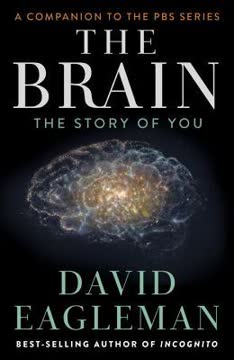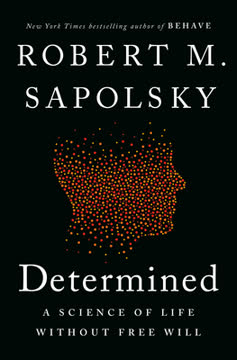Key Takeaways
1. The brain's complexity: Fear, memory, and sleep
"Although we've learned a great deal about the brain, there's still much more about it that's unexplained."
Fear is multifaceted. While the amygdala plays a crucial role in fear processing, it's not the sole "fear center." Fear involves complex networks of brain regions, with different types of fear activating distinct neural pathways. This complexity explains why some people, like SM with damaged amygdalae, can still experience certain types of fear.
Memory formation is intricate. The hippocampus is vital for memory consolidation, but it's part of a larger system. Long-term potentiation, the strengthening of synaptic connections, underlies memory formation. This process occurs not only in the hippocampus but throughout the brain, explaining why some memories persist even with hippocampal damage.
Sleep serves multiple functions. Beyond rest, sleep is crucial for:
- Memory consolidation
- Metabolic waste clearance
- Emotional regulation
- Cognitive performance
The brain's sleep-wake cycle is regulated by complex interactions between neurotransmitters, circadian rhythms, and various brain regions, highlighting the intricate nature of this seemingly simple process.
2. Language and attention: The foundations of human cognition
"Language is not just one skill, but an assortment of many."
Language is distributed. Contrary to the classic model focusing solely on Broca's and Wernicke's areas, language processing involves widespread brain networks. This distributed nature explains why some patients with localized brain damage can still retain certain language abilities.
Attention is limited. The brain's attentional capacity is finite, operating like a spotlight or bottleneck. This limitation explains phenomena like:
- Inattentional blindness (e.g., missing a gorilla in a video while focusing on other tasks)
- Difficulties with multitasking
- The rarity of true "supertaskers" (only about 2.5% of people)
ADHD is complex. Attention-deficit/hyperactivity disorder involves more than just dopamine imbalances. While stimulant medications can improve symptoms, they may not address the underlying neurological differences, explaining why long-term outcomes can be mixed.
3. Emotions and pain: The brain's regulatory systems
"Pain is more than just the unpleasant sensation of something like a needle piercing your skin. It's all of the associated cognition and emotion that goes along with it."
Emotion regulation is multifaceted. The brain's emotional processing involves various regions, including:
- The amygdala (fear and emotional learning)
- The prefrontal cortex (emotion regulation)
- The insula (interoception and emotional awareness)
- The cingulate cortex (emotional integration)
This complexity explains why emotional disorders can manifest in diverse ways and why treatments often need to target multiple systems.
Pain is subjective. The brain's pain processing involves:
- Sensory components (e.g., location, intensity)
- Emotional components (e.g., unpleasantness, fear)
- Cognitive components (e.g., attention, memory)
This multidimensional nature of pain explains why pain experiences can vary greatly between individuals and why treatments need to address more than just sensory aspects.
4. Vision and movement: How we perceive and interact with the world
"Vision is not just one skill, but an assortment of many."
Visual processing is hierarchical. The visual system involves:
- Retinal processing
- Thalamic relay
- Primary visual cortex processing
- Higher-order visual area processing
This hierarchical structure explains phenomena like blindsight, where patients with damage to the primary visual cortex can still respond to visual stimuli without conscious awareness.
Movement control is distributed. Motor control involves:
- The motor cortex (movement initiation)
- The basal ganglia (movement selection and inhibition)
- The cerebellum (movement coordination and timing)
- The spinal cord (reflexes and pattern generation)
This distributed control explains why movement disorders can manifest in diverse ways, from Parkinson's disease (basal ganglia dysfunction) to cerebellar ataxia (cerebellum damage).
5. Pleasure and addiction: The dark side of reward
"Addiction is not a simple choice, but more akin to a psychiatric disorder like depression."
Reward is complex. The brain's reward system involves more than just dopamine, including:
- Opioid systems (pleasure)
- Glutamate systems (learning)
- GABA systems (inhibition)
This complexity explains why addiction is difficult to treat with single-target approaches.
Addiction changes the brain. Chronic substance use leads to:
- Altered reward sensitivity
- Impaired impulse control
- Enhanced stress reactivity
- Persistent cravings
These changes explain why addiction is considered a chronic, relapsing disorder rather than a moral failing.
6. Neuroplasticity: The brain's ability to change and adapt
"Learning about the brain is a venture that has no finishing line or point of completion."
The brain is adaptable. Neuroplasticity allows for:
- Learning and memory formation
- Recovery from brain injury
- Adaptation to sensory loss (e.g., enhanced auditory processing in blind individuals)
This adaptability explains phenomena like phantom limb sensations and the brain's ability to rewire itself after stroke.
Critical periods exist. The brain is especially plastic during certain developmental windows, explaining why:
- Language acquisition is easier in childhood
- Early intervention is crucial for developmental disorders
- Some skills (e.g., perfect pitch) are rarely acquired in adulthood
Understanding these critical periods has important implications for education and rehabilitation strategies.
7. Neuroscience's evolving understanding: Limitations and future directions
"Our understanding of the brain is always evolving, and—like other scientific disciplines—neuroscience is constantly correcting itself."
Current limitations. Neuroscience faces challenges in:
- Understanding complex, emergent phenomena (e.g., consciousness)
- Translating animal research to human applications
- Developing targeted treatments for neurological disorders
These limitations explain why some neurological conditions remain difficult to treat effectively.
Future directions. Promising areas of research include:
- Brain-computer interfaces
- Optogenetics (controlling neurons with light)
- Advanced neuroimaging techniques
- Computational neuroscience
These emerging fields hold potential for revolutionizing our understanding of the brain and developing novel treatments for neurological and psychiatric disorders.
Last updated:
FAQ
What's Your Brain, Explained about?
- Exploration of Neuroscience: The book delves into the complexities of the human brain, explaining its functions and quirks in accessible language. It combines historical neurology cases with modern research findings.
- Ten Key Functions: Marc Dingman organizes the content into ten chapters, each focusing on a different aspect of brain function, such as fear, memory, sleep, language, and movement.
- Accessible for All: Written for readers without a neuroscience background, the book aims to make the science of the brain understandable and engaging, avoiding oversimplification while still being digestible.
Why should I read Your Brain, Explained?
- Engaging Narrative Style: Dingman presents neuroscience like a collection of detective stories, making complex topics relatable and interesting, which helps maintain reader engagement.
- Foundation for Understanding: The book serves as an excellent primer for anyone interested in how the brain works, providing foundational knowledge that can enhance understanding of future developments in neuroscience.
- Practical Applications: Insights from the book can be applied to everyday life, enhancing understanding of mental health, learning, and personal development.
What are the key takeaways of Your Brain, Explained?
- Interconnected Brain Functions: The book emphasizes that brain functions like emotion and memory are interconnected through complex networks, challenging the notion of distinct "centers" for each function.
- Neuroplasticity Importance: Dingman highlights the brain's ability to adapt and change through neuroplasticity, crucial for learning and recovery from injuries.
- Role of Neurotransmitters: The book discusses the significance of neurotransmitters like dopamine and serotonin in regulating mood, behavior, and cognition.
What are the best quotes from Your Brain, Explained and what do they mean?
- “The brain is far from perfect...”: This quote underscores the brain's remarkable capabilities despite its imperfections, highlighting the ongoing quest to understand its functions.
- “Explaining the brain completely...”: Reflects the complexity of the brain and the vast amount of knowledge still to be uncovered in neuroscience.
- “Attention is a limited resource.”: Points to the brain's capacity to focus on specific stimuli while filtering out distractions, emphasizing the challenges of multitasking.
How does Your Brain, Explained explain the concept of fear?
- Role of the Amygdala: The book discusses the amygdala as the brain's "fear center," responsible for detecting threats and initiating the fight-or-flight response.
- Fear Conditioning: Dingman explains fear conditioning as a learning process where neutral stimuli become associated with fear responses, demonstrating how the brain learns to recognize danger.
- Complexity of Fear: Emphasizes that fear involves a network of brain regions, illustrating the complexity of emotional responses.
What does Your Brain, Explained say about memory?
- Types of Memory: The book categorizes memory into short-term and long-term, explaining how short-term memory is fleeting while long-term memory can last a lifetime.
- Hippocampus's Role: Highlights the hippocampus as crucial for forming and consolidating memories, detailing its interaction with other brain regions.
- Memory Formation Process: Describes how memories are created through synaptic connections and long-term potentiation, emphasizing their importance in learning and retention.
How does Your Brain, Explained address the topic of sleep?
- Importance of Sleep: Discusses sleep as essential for brain function, highlighting its restorative properties and role in memory consolidation.
- Sleep Stages: Outlines the different stages of sleep, including REM and slow-wave sleep, explaining their unique characteristics and functions.
- Sleep Disorders: Touches on conditions like narcolepsy and insomnia, illustrating how disruptions in sleep can impact health and cognitive function.
What insights does Your Brain, Explained provide about language?
- Language Processing Areas: Identifies Broca’s and Wernicke’s areas as critical for language production and comprehension, explaining how damage can lead to disorders.
- Complexity of Language: Emphasizes that language involves multiple brain regions and networks, challenging the idea of localized "centers" for language functions.
- Critical Period for Language Acquisition: Discusses the concept of a critical period for language learning, suggesting early exposure is crucial for developing linguistic abilities.
How does Your Brain, Explained explain the relationship between emotions and the brain?
- Amygdala's Role: Central to processing emotions, particularly fear and anxiety, acting as a threat detector.
- Emotional Regulation: Discusses how different brain regions, including the prefrontal cortex, regulate emotional responses, crucial for managing emotions.
- Impact on Behavior: Emphasizes that emotions significantly influence behavior and decision-making, helping readers navigate emotional experiences.
What is hemispatial neglect as described in Your Brain, Explained?
- Definition of Hemispatial Neglect: A condition where individuals fail to attend to one side of their visual field, often due to right parietal lobe damage.
- Symptoms and Behaviors: Patients may only eat from one side of their plate or fail to groom one side of their body, leading to significant daily challenges.
- Cognitive Implications: Highlights the brain's role in attention and perception, demonstrating how damage can disrupt normal cognitive processes.
How does Your Brain, Explained address the topic of addiction?
- Dopamine's Role: Explains how dopamine is involved in the brain's reward system, influencing feelings of pleasure and motivation.
- Addiction as a Disorder: Presents addiction as a complex disorder influenced by neurobiological changes, encouraging a compassionate understanding.
- Treatment Challenges: Discusses difficulties in treating addiction, including relapse risk and withdrawal symptoms, emphasizing comprehensive approaches.
What is the significance of neuroplasticity in Your Brain, Explained?
- Adaptability of the Brain: Neuroplasticity refers to the brain's ability to reorganize itself by forming new neural connections throughout life.
- Implications for Learning: Suggests that engaging in new experiences and learning can physically change the brain, highlighting lifelong learning's importance.
- Recovery Potential: Provides hope for individuals recovering from brain injuries, underscoring the potential for rehabilitation through targeted therapies.
Review Summary
Your Brain, Explained receives positive reviews for its accessible introduction to neuroscience. Readers appreciate the author's engaging writing style, fascinating case studies, and ability to explain complex concepts clearly. The book covers various brain functions, debunks myths, and sparks curiosity. Many find it informative and thought-provoking, praising its balance between scientific depth and readability. Some readers note that the broad coverage means topics aren't explored in great detail. Overall, it's recommended for those interested in learning about the brain, regardless of prior knowledge.
Similar Books










Download PDF
Download EPUB
.epub digital book format is ideal for reading ebooks on phones, tablets, and e-readers.




